Chapter
10
Changing
Times for James & Agnes
By
the end of 1753, James and Agnes had completed their family. Both of
them were 39 years old, and Agnes had just given birth to her last
son, Edmund. They were established property owners
in one of the largest and most influential
colonies in North America. Virginia would continue to play a major
role in the historical events that were beginning to unfold. The
city of Williamsburg had been chosen as the capital of the
Commonwealth, and “it was here that the
convention adopted the Virginia Bill of Rights on June 12, 1776.”
(Ref 1026) There was a
restless wind of change that was blowing, however, and the
repercussions would be felt in more than just the Old Dominion. The
events leading up to the Revolutionary War and the final break with
Great Britain were rooted in problems that had been simmering for
quite some time.
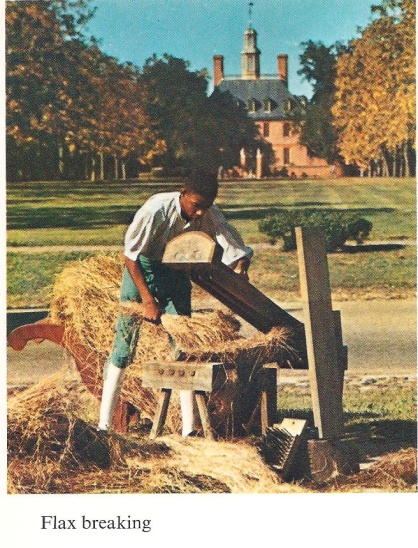
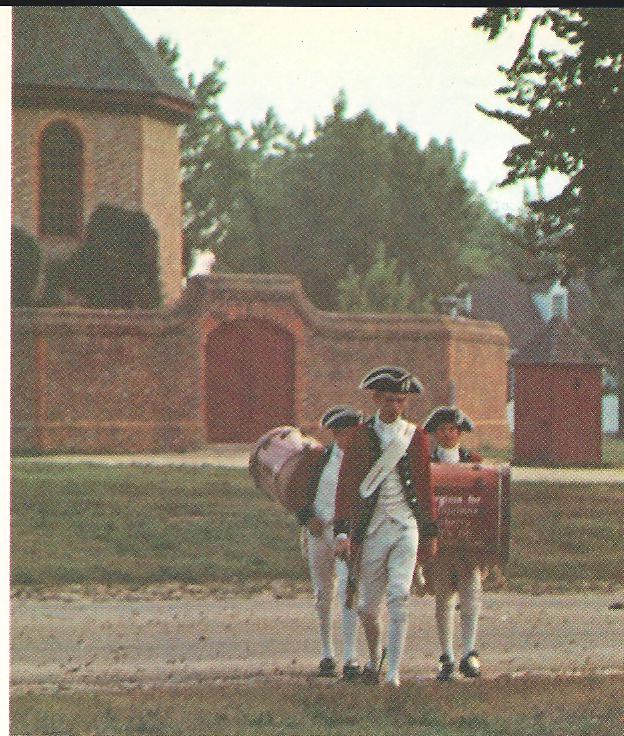 Photos
from Colonial Williamsburg
Photos
from Colonial Williamsburg
When
the colonists came from England to settle in the New World back in
the 1600s, one of the driving motivations was the desire for
religious freedom. To some small extent they may have found that in
this new land, but old bigotries and the natural inclination for men
to want to judge others followed them. Even the Puritans, zealous in
their own struggle to practice their faith in freedom, resorted to
“torture and imprisonment of many leaders of
non-Puritan Christian sects which led to the ‘banishment’ of many
Christian leaders and their followers from the Massachusetts Bay
Colony.” (Ref.
Wikipedia) Virginia fared no
better. “The
law of the land mandated that white Virginians worship in the
Anglican Church [Church
of England] and
support its upkeep with their taxes. Where religion was an integral
part of everyday life in Virginia, the lines blurred between
religious and civil authority.”
(Ref. History of
Religion.org)
The
established Episcopal Church was held dear by many of this country’s
first settlers, including the Ware family. Records attest to their
membership and active roles in the church - holding positions of
honor and high respect. The religious life of Virginians was not
without diversity, however, and those choosing different
denominations in which to worship chafed at legal restrictions placed
on them. “Finally,
after about 1750, evangelical Christians precipitated a struggle for
religious freedom parallel to and often reciprocal with the wider
struggle for political independence.”
(Ref. History of
Religion.org)
We
know that James and Agnes were both born in Gloucester County, but
the years following their marriage would find them living in new
counties being formed further inland. The maps below show the
settlement path the couple took during the years from their own birth
to just prior to their move to Kentucky.
X
Gloucester X
King and Queen X
Caroline X
Spotsylvania X
Orange X
Culpeper X
Frederick
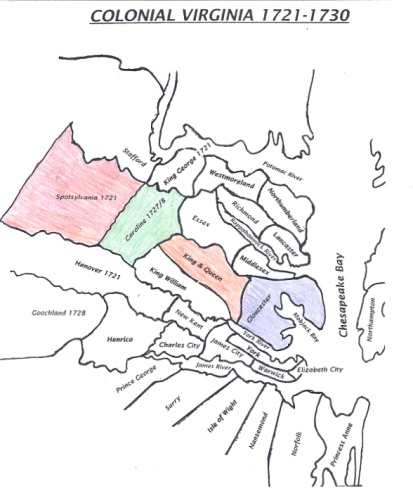
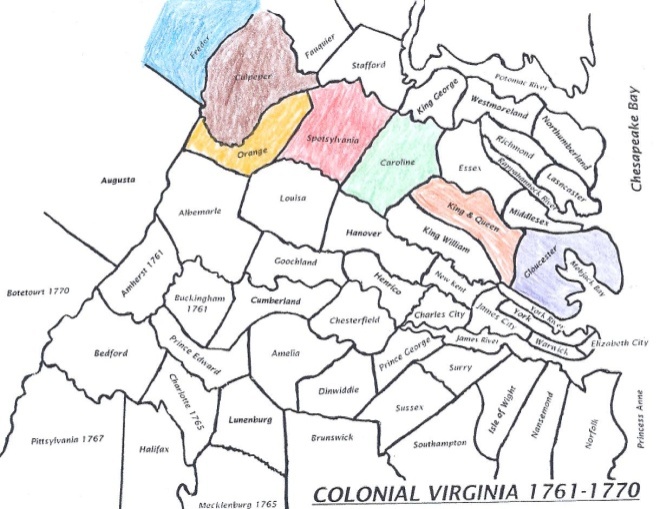 1721-1730
1761 – 1770
1721-1730
1761 – 1770
The
following map gives us a good idea of how their world changed in the
nine years most of the Ware children were being born. Shaded areas
represent newly formed counties from 1741 to 1750. Virginia was
growing as quickly as the Ware family.
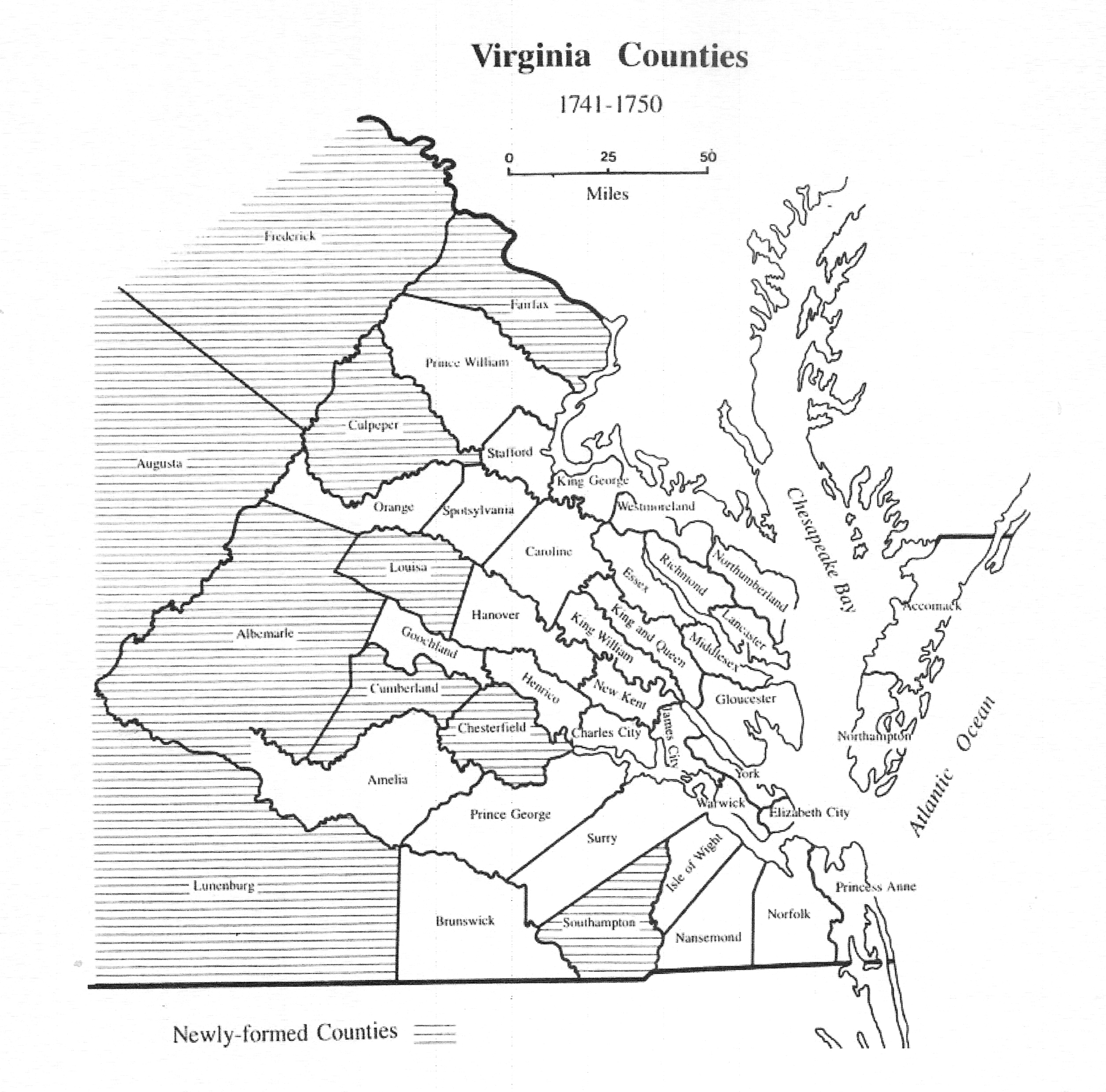
- With
growth comes change, however, and the religious climate of Virginia
was evolving as well. As author Shelley D. Bailess wrote:
-
“The
period from 1769 to 1775 saw the
rise of the Baptist evangelist, an increase in the number of
converts and churches and as a result, more determined persecution
from the Anglican establishment . . . . By the time of the American
Revolution, Separate Baptists numbered more than ten thousand, and
by 1790, there were more than two hundred Baptist churches and one
hundred and fifty ordained ministers in the denomination in
Virginia. Their enthusiasm, the rapid rise in their membership, and
their place in the social order created an environment of opposition
that soon developed into open oppression - and resulted in the drive
for religious liberty in Virginia.” (Ref.
2567)
- From
documents and records found in the Virginia and Kentucky archives, a
picture appears which leads us to believe that James Ware Sr. was
highly involved in this exploding religious movement. There were
many vibrant, inspiring ministers who adhered to this new faith, and
each of the major Baptist ministers mentioned below (Hickman,
Taylor, Craig, and Marshall) were acquainted with (and had
interactions with) James and his family in some way. The following
timeline and attached documents with explanations will support the
conclusion that James
Ware Sr. came to Kentucky with the
Traveling Church.
-
X
JAMES Sr. X
HICKMAN X JAMES
Jr. X TAYLOR
X CRAIG
- X
MARSHALL
X SINGLETON
-
1767
– On November 20, 1767, a new church is started and named Upper
Spotsylvania Baptist Church. (Spotsylvania
and Caroline Counties had both been formed in the 1720s as the
population moved further inland from Gloucester.) One of the
members of the new church is Christopher
Singleton who
will later come to the support of James
Ware Sr.
-
 The
name Christopher
Singleton
is on Morgan Edward's list of the first members of the Upper
Spotsylvania Church, one of the first Baptist churches (or perhaps
the first) in Virginia. This was around 1767.
The
name Christopher
Singleton
is on Morgan Edward's list of the first members of the Upper
Spotsylvania Church, one of the first Baptist churches (or perhaps
the first) in Virginia. This was around 1767.
- FREDERICKSBURG
BAPTIST CHURCH by Oscar M. Darter, 1960 (Richmond, Va.), citing the
Morgan Edwards MSSS, American Baptist Historical Society, Crozier
Theological Seminary,Chester, Penn
- 1768
– William Marshall
is converted and begins preaching in the Shenandoah area of Virginia
(i.e., Frederick County) where James
Jr. (Dr. James Ware) will later live
in 1770.
-
1769
– James
Sr. and
James Jr.
both
start out
living in
Caroline County, but James
Jr. ends up moving to Winchester,
Virginia - in Frederick County. Frederick
Co. is blue, Spotsylvania
Co. is red, and Caroline
Co. is green
-
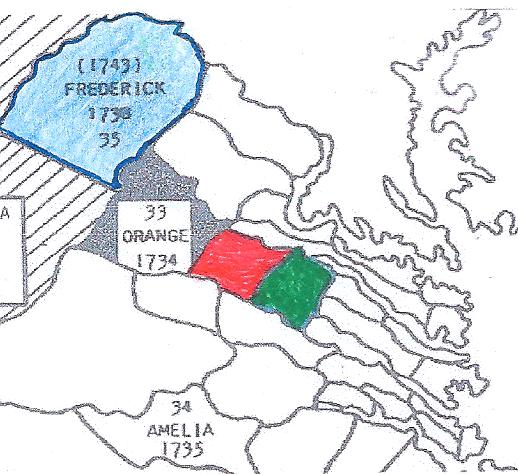
-
Marshall
has been preaching in the area and performed the first baptism in
the Shenandoah River. John Taylor
is
converted by Marshall
and begins preaching.
- 1770
– Lewis
Craig
becomes the
minister of Upper Spotsylvania Church
where several references tell us James
Sr.
attended. At age 56, James
Sr. and his wife, Agnes, start to
sell off their property which they own in Spotsylvania. (See below)
-

-
May
7, 1770.
Spotsylvania Co., VA. James WARE &
wife Agnes of Caroline Co.,
VA, to John CHICK of Hanover Co., VA, 100 acres in Spotsylvania
County for £1, 5s. Witnesses to the deed were Wm. CROW, Francis
BABER, & Nichol. WARE. On this same date, John CHICK witnessed
several other deeds from James & Agnes WARE to various
individuals, for parcels of land in St. George's Parish,
Spotsylvania Co. In all, James & Agnes WARE conveyed 8
parcels of land on May 7, 1770. Along with John CHICK, the grantees
were Nathaniel HILL of Hanover Co., James RIDDLE of Caroline Co.,
Ezekiel MITCHELL of Caroline Co., Humphrey HALEY of Caroline Co.,
Thos. UPSHAW of Essex Co., Wm. CROW of King & Queen Co., and
Francis BABER of Caroline Co.
-
(Spots.
Co., VA, Deed Book G, 1766-1771).

-
On May
7, 1770, in Spotsylvania County, the couple
“held a land lottery selling 1,000 acres,
in 100 acre increments, which were drawn in Ware’s
Lottery.”
(Ref. 6,379) The Virginia County Deed Book states that one of those
transactions was between “James
Ware and
Agnes, his wife, of Caroline
County to Ezekiah Mitchell of said county.”
(Ref. 5) On the same date, “James
Ware and Agnes (his wife of
Caroline County) deeded to Nathaniel Hill 100 acres in St. George
Parish Spotsylvania County, which land Hill won as a prize in the
Ware’s Lottery.”
- According
to the Spotsylvania County Records of
1721-1800, the following land transactions
were also done by James
Sr. and Agnes during this time:

-
May
7, 1770 James
Ware and Agnes his wife of
Caroline Co. to James Riddle of said county - 100 acres in
Spotsylvania Co., in St. George Parish which said land was drawn in
Ware’s Lottery
-
-

-
May
7, 1770 James
Ware and Agnes his wife of
Caroline Co. to Humphrey Haley of said county – 100 acres in St.
George Parish, Spotsylvania Co. drawn in Ware’s Lottery
-

-
May
7, 1770 James
Ware and Agnes his wife of
Caroline Co. to Thomas Upshaw of Essex Co. – 100 acres in St.
George Parish, Spotsylvania Co. drawn in Ware’s Lottery

-
May
7, 1770 James
Ware and Agnes his wife of
Caroline Co. to William Crow of King & Queen Co. – 100 acres
in St. George Parish, Spotsylvania Co. drawn in Ware’s Lottery
-

-
May
7, 1770 James
Ware of Caroline Co. and Agnes,
his wife, to Francis Barber of same county – 100 acres in St.
George Parish, Spotsylvania Co. drawn in Ware’s Lottery
-
- 1771
– Louis
Craig
is arrested in Caroline County (where James
Sr.
and Agnes still live) for preaching. James
Sr. is
also
arrested for preaching in Fredericksburg,
the county seat for Spotsylvania.
-
- 1772
- James Ware
Sr.
is arrested for preaching in
Caroline County and is given aide by
Christopher Singleton.
James Sr.
and Agnes sell some of their last
land in Spotsylvania, and the transaction is recorded by Nathaniel
Holloway who will also
be arrested for preaching in Caroline County that year.
(See following documentation for land sale and the arrest of James
Ware Sr.)
-
Dec.
5, 1772
James
Ware and Agnes,
his wife, of Caroline County, to
John Knight of Spts. Co. 15 Lbs curr. 100 acres in Spts. Co.
Nathaniel Holloway,
Thomas Wisdom. March 18, 1772
- Spotsylvania
County Records Crozier, page 296
 “James
Pitman
. . . was
arrested in 1772
along with James
WARE
and
imprisoned
for 16 days in Caroline County's jail for having preached in
their
home."
Caroline
County, VA, Order
Book,
1772-1776
“James
Pitman
. . . was
arrested in 1772
along with James
WARE
and
imprisoned
for 16 days in Caroline County's jail for having preached in
their
home."
Caroline
County, VA, Order
Book,
1772-1776
 “Ware's
arrest for
preaching at James Pitman's tavern . . . marked
another turning point in the propagation of the Baptist faith in
Caroline County . . . . Powerful friends came to
Ware's
rescue
after he "got into trouble." William Taliaferro and
Christopher
Singleton,
rich planters of the great landlord caste, offered to post bond for
his good behavior. This was the first instance of record that great
landlords befriended a Baptist in Caroline since Daniel Stover faced
the local court, over two decades before. But
Ware
was
not willing to accept this bond on the usual conditions, supported
by Taliaferro and Singleton he contended that "keeping the
peace" he construed literally and not as a bar to preaching.”
Colonial
Caroline, A History of Caroline County, Virginia,
by T. E. Campbell, The Dietz Press, Inc, Richmond VA, 1954.
“Ware's
arrest for
preaching at James Pitman's tavern . . . marked
another turning point in the propagation of the Baptist faith in
Caroline County . . . . Powerful friends came to
Ware's
rescue
after he "got into trouble." William Taliaferro and
Christopher
Singleton,
rich planters of the great landlord caste, offered to post bond for
his good behavior. This was the first instance of record that great
landlords befriended a Baptist in Caroline since Daniel Stover faced
the local court, over two decades before. But
Ware
was
not willing to accept this bond on the usual conditions, supported
by Taliaferro and Singleton he contended that "keeping the
peace" he construed literally and not as a bar to preaching.”
Colonial
Caroline, A History of Caroline County, Virginia,
by T. E. Campbell, The Dietz Press, Inc, Richmond VA, 1954.
 “There
was preaching in the homes in 1771-1773 by such preachers as Lewis
CRAIG
and John WALLER. This was unlawful so at least two citizens, James
WARE and
James PITMAN, were jailed for allowing their homes to be used for
such a gathering.”
Virginia
Baptist Historical Society in Richmond, Virginia
“There
was preaching in the homes in 1771-1773 by such preachers as Lewis
CRAIG
and John WALLER. This was unlawful so at least two citizens, James
WARE and
James PITMAN, were jailed for allowing their homes to be used for
such a gathering.”
Virginia
Baptist Historical Society in Richmond, Virginia
“In
Caroline Co. VA Christopher
and his family supported a Baptist minister, James
Ware,
who was being persecuted for preaching the first noted open, public
sermon (in James Pittman's tavern). Christopher
Singleton
is noted as a "Powerful friend" and being a "rich
planter of the great landlord caste.’"
Coastal
Carolina
 “. . . there had
been violent opposition to the Baptists in that neighborhood,
the parson of the parish preaching against them, and warrants being
issued for the apprehension of Lewis
Craig, Edward Herndon,
Bartholomew Choning, James Goolrick, James
Ware and James Pitman, all
of whom were thrown in prison.”A
History of the Ten Baptist Churches
by John Taylor, 2nd
Edition (1827)
“. . . there had
been violent opposition to the Baptists in that neighborhood,
the parson of the parish preaching against them, and warrants being
issued for the apprehension of Lewis
Craig, Edward Herndon,
Bartholomew Choning, James Goolrick, James
Ware and James Pitman, all
of whom were thrown in prison.”A
History of the Ten Baptist Churches
by John Taylor, 2nd
Edition (1827)
 “James
Ware- Church
Layman” The
Baptists of Virginia, 1699-1926
by: Garnett Ryland
“James
Ware- Church
Layman” The
Baptists of Virginia, 1699-1926
by: Garnett Ryland
 “In
1922, a monument was dedicated in Bowling Green to the memory of six
Baptist ministers who were imprisoned in the Caroline County jail in
1771. The monument has since been moved to Carmel Baptist Church,
the oldest church of this faith in the county. The names appearing
on this monument are: Bartholomew Chewning (also spelled Choning),
John Young, Lewis
Craig,
Edward Herndon, John Burrus and James Goodrich (also spelled
Goolrich). Several of these names will appear in the following
narratives of the four Baptist churches established in this
immediate area . . . coming to their defense was Patrick Henry of
Hannover. Such names as John Waller, James Pittman, James
Ware,
Hipkins Pitman and Younger Pittman will also appear in connection
with these Churches: and these men were imprisoned, whipped or
threatened during their ministry in this county, also. Some were
imprisoned many times in the Fredericksburg jail and jails of
surrounding counties.” (Website)
“In
1922, a monument was dedicated in Bowling Green to the memory of six
Baptist ministers who were imprisoned in the Caroline County jail in
1771. The monument has since been moved to Carmel Baptist Church,
the oldest church of this faith in the county. The names appearing
on this monument are: Bartholomew Chewning (also spelled Choning),
John Young, Lewis
Craig,
Edward Herndon, John Burrus and James Goodrich (also spelled
Goolrich). Several of these names will appear in the following
narratives of the four Baptist churches established in this
immediate area . . . coming to their defense was Patrick Henry of
Hannover. Such names as John Waller, James Pittman, James
Ware,
Hipkins Pitman and Younger Pittman will also appear in connection
with these Churches: and these men were imprisoned, whipped or
threatened during their ministry in this county, also. Some were
imprisoned many times in the Fredericksburg jail and jails of
surrounding counties.” (Website)
Meanwhile,
as James
Sr. is
preaching, James Jr. is
getting established in his new home in Winchester.
“In October 1772,
James Ware was
appointed overseer of the road leading from Berry’s Ferry (where US
Route 50 crosses the Shenandoah River) to Winchester. Part of this
old road is still in use and crosses the road leading from Boyce to
Old Chapel near New Market.” (Ref. 203, 272, 322)
 Records
for Overseer
Records
for Overseer
Later, in
1782, it is recorded that
James,
“along with
Edward Smith and other inhabitants of Winchester, communicated with
the Executive of Virginia. They were setting forth reasons why the
British prisoners [being
held] in barracks
near Winchester should not be moved.”
(Ref. 372)
(Calendar of VA
state papers)
These soldiers had been “part
of the army of General John Burgoyne, who was defeated at Saratoga in
1777 by General Horatio Gates.”
(Ref. 2570)
- 1773
- James Sr. is
still attending Upper Spotsylvania Church. There is another “Ware”
activist who gets arrested, but he is not from the same family tree.
This “Robert” Ware lived and preached around Essex County, and
he never moved to Kentucky. The following is taken from a book by
Alfred Bagby titled King and Queen County,
Virginia, published in 1908, and it shows
that Robert never left Virginia:
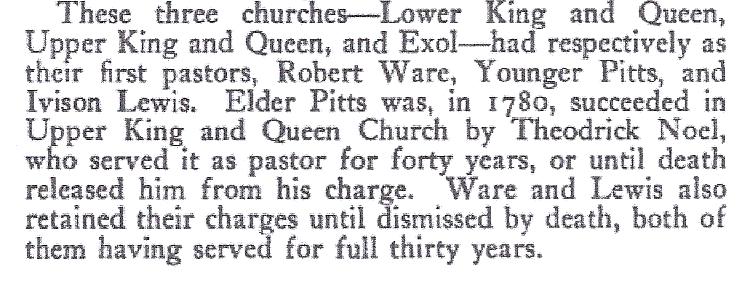 Excerpt
from book
Excerpt
from book
-
The
following list was found in the book Imprisoned
Preachers and Religious Liberty in Virginia
by Lewis Peyton Little (J. P. Bell Co., Inc., Lynchburg, VA, 1938.)
It shows where the two Ware men resided and the connection between
Louis
Craig
and James
Ware.
- Caroline
County
1.
Burrus, John- Jailed for preaching
2.
Choning, Bartholomew- Jailed for (?)
3.
Craig, Lewis-
Arrested and required to give bond
4.
Craig, Lewis-
Jailed for preaching “Three months”
5.
Craig, Lewis-
Carried to Williamsburg on habeas corpus
6.
Goolrich, James- Jailed for preaching
7.
Herndon, Edward- Jailed for preaching
8.
Pitman, Hipkins- Arrested and threatened with whipping
9.
Pitman, James- Jailed for preaching “Sixteen days”
10.
Pitts, Younger- Arrested, abused and released
11.
Waller, John- Jerked off stage—head beaten against ground
12.
Waller, John- Whipped severely by the Sheriff
13.
Waller, John- Jailed for preaching (Ten days)
14.
Ware, James-
Jailed for preaching (Sixteen days)
- 15.
Young, John- Jailed for preaching (Five or six months)
- Essex
County
1.
Lewis, Ivison- Arrested but not imprisoned
2.
Shackelford, John - Jailed for preaching (Eight days)
3.
Waford, Thomas- Arrested, searched and released
4.
Waller, John- Jailed for preaching (Fourteen days)
- 5.
Ware, Robert -
Jailed for preaching (Eight days)
-
- 1774
– Cornstalk, a prominent leader of the
Shawnee nation prior to the American Revolution, is defeated in the
French and Indian War. In May of 1774, the militia of Frederick
County had been put into service against the Indians. One of the
most notable citizens, Captain Daniel Morgan, is a close associate
of James Jr.,
who will later help his son, James
Ware III. This Frederick County company served for 164 days.

-
-
 “Through
the friendship of General Daniel Morgan, he (James III) obtained an
introduction to General S. Smith of Baltimore, whence he commenced
merchandizing in Louisville.” (Ref.
2, 6, 35)
“Through
the friendship of General Daniel Morgan, he (James III) obtained an
introduction to General S. Smith of Baltimore, whence he commenced
merchandizing in Louisville.” (Ref.
2, 6, 35)
- 1775
– Taylor
visits
Kentucky and stays about a year but
then returns to Virginia where he will soon meet James
Jr. in Winchester. Christopher
Singleton, who had come to the aide
of James
Sr.
when he was arrested, moves to Kentucky. Lewis
Craig
(although still preaching for the church)
becomes a verbal and adamant proponent for the fight against
England.
-
- 1776
– The country is now at war with Great
Britain, and both James
Ware Jr. and James
Ware Sr. do patriotic service in one
way or another. (See documentation below)
There is also a great revival in Upper Spotsylvania Church, and
over 100 people are added to its membership.
-



 Ware
Family History
American Genealogical Research Institute, Washington DC, Heritage
Press, 1978
Ware
Family History
American Genealogical Research Institute, Washington DC, Heritage
Press, 1978

 (Ref. 894)
(Ref. 894)
DAR
Patriot
Index Centennial Edition, Part III,
Washington, 1994
 “James
Ware Sr.
did patriotic service in Virginia.”
American
Genealogical Research Institute in Washington, D.C.
“James
Ware Sr.
did patriotic service in Virginia.”
American
Genealogical Research Institute in Washington, D.C.
 James
Ware “rendered service in the revolution, as did several of his
sons, and . . . he moved to Kentucky after
hostilities had subsided.”
The Register of the
Kentucky State Historical Society,
Vol. 19 KY
James
Ware “rendered service in the revolution, as did several of his
sons, and . . . he moved to Kentucky after
hostilities had subsided.”
The Register of the
Kentucky State Historical Society,
Vol. 19 KY
 Military
history information for James
Ware, husband of Agnes Todd
- LDS AFN: GPOX-70 Latter Day Saints record
Military
history information for James
Ware, husband of Agnes Todd
- LDS AFN: GPOX-70 Latter Day Saints record
 Military
records show James Jr.
was “a
cavalry soldier in a Virginia unit.” He
is listed as a Revolutionary War Patriot.
Military
records show James Jr.
was “a
cavalry soldier in a Virginia unit.” He
is listed as a Revolutionary War Patriot.
 DAR Patriot
Index, 2003, NSDAR
DAR Patriot
Index, 2003, NSDAR

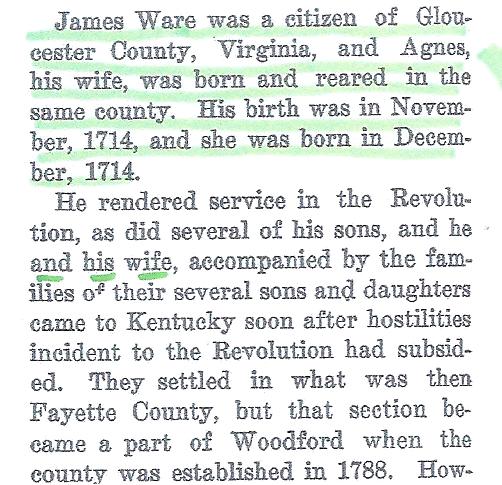
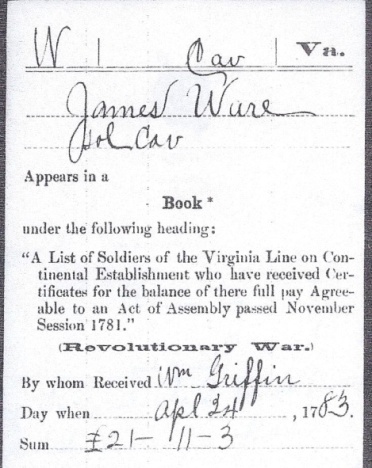 Revolutionary
War Pension
Revolutionary
War Pension
James
Senior
James Junior
- 1777
– James Sr. and Agnes
Ware still in Caroline County
-
 Forks of
Elkhorn Church,
by Emina Jett Darnell, 1939
Forks of
Elkhorn Church,
by Emina Jett Darnell, 1939 -
- 1778
– Plans are discussed at Upper
Spotsylvania Church about moving to Kentucky.
-
- 1779
– The winter weather this year is
unusually bitter. “It
was fixed in the minds of the early pioneers as the ‘Hard Winter
of 1779-1780’
. . . heavy snows and low temperatures brought extreme distress to
human and beast over an extended time.” (Ref.
2570)
Lewis Craig
comes with Captain William Ellis to explore the possibility
of moving to Kentucky. (It will take two years to make all the
preparations.) Virginia is authorized to send
militia into South Carolina – thereby laying the groundwork for
Nicholas Ware (who will serve there) to make his future decision to
permanently move to the area. Nicholas, son of James
Sr. and brother of James
Jr., had been attending Broad Run
Baptist Church in nearby Fauquier County with his wife since 1773.
-
 NICHOLAS
WARE APPOINTED CLERK 1773 Church
Record
NICHOLAS
WARE APPOINTED CLERK 1773 Church
Record -
-
 By his
military record, we know Nicholas served in South Carolina, and
according to T. E. Campbell in his book titled
Colonial Caroline, A History of Caroline
County, Virginia, Nicholas was “listed
as a Lieutenant in the Militia in the year 1762, but he eventually
reached the rank of Colonel.” In 1783,
Nicholas would take his wife and family to South Carolina to “start
the Turkey Creek Baptist Church.”
Minutes of Broad Run Baptist Church,
Fauquier Co., Va., 1762-1872.
By his
military record, we know Nicholas served in South Carolina, and
according to T. E. Campbell in his book titled
Colonial Caroline, A History of Caroline
County, Virginia, Nicholas was “listed
as a Lieutenant in the Militia in the year 1762, but he eventually
reached the rank of Colonel.” In 1783,
Nicholas would take his wife and family to South Carolina to “start
the Turkey Creek Baptist Church.”
Minutes of Broad Run Baptist Church,
Fauquier Co., Va., 1762-1872. -
 “NICHOLAS
WARE OCT 25 DISMISSED TO SOUTH CAROLINA -MARTHA WARE OCT 25, 1783 -
DISMISSED TO SOUTH CAROLINA”
“NICHOLAS
WARE OCT 25 DISMISSED TO SOUTH CAROLINA -MARTHA WARE OCT 25, 1783 -
DISMISSED TO SOUTH CAROLINA” -
Minutes
of Broad Run Baptist Church, Fauquier Co., Va., 1762-1872.
-
- 1780
– The capital of Virginia is moved from
Williamsburg to Richmond. (Ref.
2570) A land warrant
(dated March 22, 1780) for 3,000 acres in Kentucky “for
military service rendered” is given to
James Ware Jr. He
chose not to move to Kentucky until
almost ten years later, but he obviously was looking at his options
because he did contact a man named Simon Kenton, a known surveyor
and land speculator. Kenton had a mixed reputation. Some thought
of him as a folk hero, and others found some of his actions
unscrupulous. Not only did he have an unfavorable interaction with
James Jr.,
but another lawsuit followed in 1795 between Simon and the eldest
son of James, Thompson Ware. (See
following page)
-
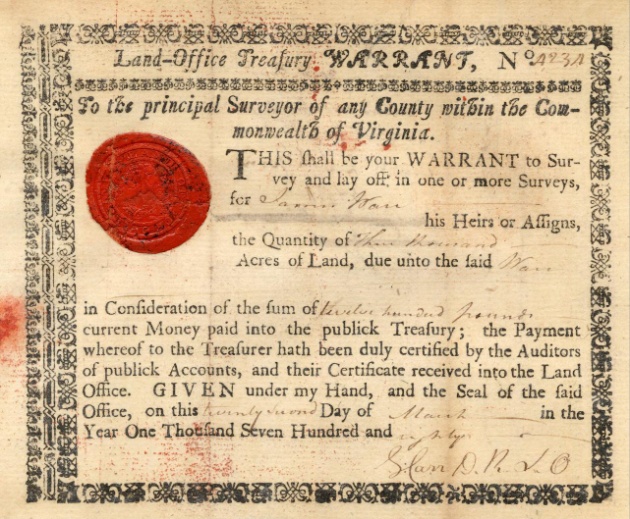 Land
warrant for James
Ware Jr.
Land
warrant for James
Ware Jr. -
 Interaction
between James Ware and Simon Kenton
Interaction
between James Ware and Simon Kenton

-
This
day came William Smith of [illegible] before me John A. Woodcock, a
Justice of the peace of same county, who being of full age deposeth
and saith that about the first of
June 1780,
being in Kentucky and empowered to purchase Land, for Mr.
James Ware,
he the deponent agreed with a
certain Simon Kenton of Kentucky for 1000 Acres of Land about 2 or 3
miles from the big salt spring on Licking, that the sd. Kenton on
condition that the sd. Smith would pay him L100 in hand and L100
more when sd. Land was surveyed, ... sd. Kenton on his part would
have the land surveyed, and a fee Simple made there to .... sd. Land
was first rate Land and had a good Spring thereon .... He agreed to
warrant and defend the same ... against all persons whatsoever ...
sworn to before me this 17th day of Nov. 1789. Later on, the
purchaser, who did not take possession of the land for eight or nine
years, feared it would not prove as fertile as Kenton had said, and
threatened to sue Kenton; but Kenton evidently had the whip-hand in
the controversy, for the land being out in the wilderness, the
purchaser did not know its exact location, and when he threatened
suit, and asked to be shown it, Kenton "swore that he would not
show it at all."
-
[Letter
of James
Ware,
Nov. 29, 1789.]
-
 Interaction
between Thompson Ware and Simon Kenton
Interaction
between Thompson Ware and Simon Kenton

-
April 6, 1795, Mason
County, Kentucky The document reads: "Know all men by these
present that I, Simon Kenton of the County of Mason & State of
Kentucky, am held & firmly bound unto Thompson Ware of
the County & State aforesaid in the Penal Sum of Three Hundred
pounds Good & Lawful money of Kentucky; I bind myself my heirs
Exors, Admors and Assigns firmly by these present sealed with my
seal and dated this 6th day of April 1795. The Condition of the
above obligation is such that if the above bound Simon Kenton his
Heirs Exors and Admors or assigns do shall well & truly pay unto
the above named Thompson Ware & his Heirs the just &
full sum of One Hundred & fifty pounds in like money as
mentioned above, on or before the 1st day of September next ensuing
for & in consideration of 1000 acres of land sold the said
Kenton then this obligation to be void else to remain in full force
& virtue in Law. (signed) Simon Kenton."
-
- 1781
- This was the big year for James
Ware Sr. and
the Upper Spotsylvania Church as the
congregation of about 200 people decided to follow Lewis
Craig into Kentucky. Marshall
had also moved to Kentucky from the Shenandoah region and was
followed shortly by what would become known as the Traveling
Church. According to author Dalla Bogan,
“One group, numbering about 500, which
included the entire Upper Spotsylvania Baptist Church congregation .
. . passed through the gap in 1781. As was common custom, they had
to abandon their wagons, loaded with personal items, and walk the
mountain trail with only what they could carry or load on horses.”
It was a journey that required great
courage, fortitude, and faith beyond measure. “The
Travelling Church was perhaps less an organized church and more of a
traveling band of disciples (some church members and some simply
pilgrims) seeking a better life in Kentucky.” (Wikipedia)
-
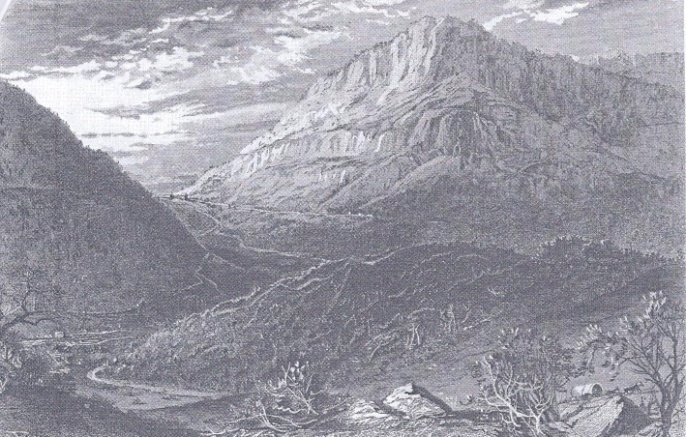 2532
2532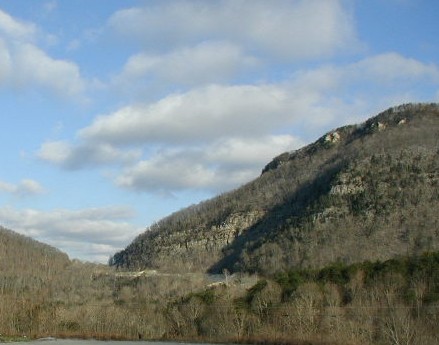 Cumberland
Gap
Cumberland
Gap
- Estimates
for the size of the Traveling Church range between 500 and 600
people. The largest group was made up of church members, their
children, and their slaves. Other emigrants who wished to travel in
a large company for safety also joined in. Military guidance was
provided by Captain William Ellis, a revolutionary soldier and
pioneer who had previously visited Kentucky in 1779. Ellis would
become one of the foremost settlers in early Kentucky and an early
member of the Bryant's Station and David's Fork churches.
Some Ware
family members would
also attend the David’s Fork church later.
-
As
John Taylor
wrote in his diary, the church in Virginia “prospered
as long as Mr.
Craig remained with it in its
first location. Mr. Craig continued to serve Upper Spotsylvania
church as pastor, till 1781, when he moved to Kentucky. So strongly
was the church attached to him, that most of its members came with
him.” With the history and interaction
that James Ware Sr.
had with Lewis Craig
in Virginia, it would make sense that he and Agnes would become part
of this massive exodus to Kentucky. (We know the Ware patriarch was
there prior to 1790
because of the date on his will.) The following pieces of
information would seem to back up this theory.
-
George
Ranck, in his history of the Traveling Church written in 1891, gave
“a partial list of the families that were
part of this historic journey.” He wrote:
“How many died on the way, how many were
slain by savage foes and how many were injured for life by exposure,
no records remain to tell nor is there a list extant of the heroic
men and women who survived the perils of the wilderness and planted
the banner of their faith at Gilbert's Creek. The names of some of
them, however, have been secured
and are herewith appended . . . These names
were obtained from family records, ‘Ford's Repository,’
‘Virginia Baptists,’ ‘Ten Churches’ and ‘Spencer's History
of Kentucky Baptists. In most cases only the family name was given
without either the names or number of the members of the family.”
The names secured are:
- ALLEN
ELLY PRICE
-
ASHER
EASTIN ROBINSON & Wife
-
BLEDSOE
GARRARD RAMSEY
-
BOWMAN
GOODLOE RUCKER
-
BARROW
HUNT SHACKELFORD
-
BURBRIDGE
HART SHIPP
-
BUCKNER
HICKMAN SHOTWELL
-
CRAIG, Toliver &
wife HICKERSON SINGLETON
-
CRAIG,
Lewis
MARTIN SMITH
-
CRAIG, Joseph
MOORE SANDERS
-
CAVE, William
MORTON STUART
-
CURD
MARSHALL TODD
-
CARR
MORRIS THOMPSON
-
CREATH
MITCHUM WALTON
-
DUDLEY
NOEL WOOLFOLK
-
DUPUY
PAYNE WATKINS
-
DARNABY
PARRISH, Timothy WALLER
-
DEDMAN
PARRISH, James WARE
-
ELLIS, William &
PITMAN WOOLRIDGE
-
ELLIS' family of 5
PRESTON YOUNG
-
- It is
interesting to draw special attention to some names listed above.
These families had close connections with James
and Agnes Ware - making it logical that they would want to travel
together.
-
- PARRISH, James - A
grandson of James and Agnes (by
their son Edmund) marries Joannah Parrish, the daughter of James
Parrish.
-
CRAIG, Lewis - Clearly
the Wares and Craigs
were close because of the family membership in Upper Spotsylvania
Church.
- TODD – The full
name of James’ wife was Agnes
Todd Ware.
-
PITMAN – It was James
Pitman who bailed James Ware
out of jail.
-
SINGLETON – It was the
Singleton family who aided James
too.
-
PAYNE – A grandson of
James (by son John) wed Susannah
Payne.
- GOODLOE – Thomas
W. Goodloe would marry into the Ware
family in 1844.
-
MARTIN – A
granddaughter of James (by
Edmund) wed into the Martin family.
-
Once they arrived at their destination and began
their new church, named Gilbert’s Creek Baptist Church, records
show “some
of the early church member family names were Allen, Bowman, Barrow,
Burnbridge, Craig, Cave, Curd, Creath, Dudley, Dedman, Ellis,
Eastin, Garrard, Goodlow, Hunt, Hart, Hickman, Martin, Moore,
Morton, Marshall, Norris, Payne, Pitman, Preston, Price, Robinson,
Shackleford, Shipp, Singleton, Smith, Sanders, Stuart, Todd,
Thompson, Walton, Woolfolk, Watkins, Ware,
Wooldridge and Young.” (Ref. Spencer 1885)
- (More
information on the actual trip to Kentucky will follow later.)
-
- 1781
– There is a terrible drought in Virginia this year. (Ref.
2570) Lewis
Craig
and the Traveling Church arrive at Wolf
Hills by late September, and in October they hear of the British
surrender at Yorktown. There are many delays, but the party makes
it to Lincoln (now Garrard) County in December. The travelers
worship for the first time at Gilbert’s Creek, Lincoln
County “on the second Lord’s day in
December, 1781.” (Marshall
is there and preaches to them.) Lewis
Craig
and the Wares
stay at Gilbert’s Creek for two years
before relocating to a safer place to form South Elkhorn Church.
James Sr. owns
130 acres of land in Lincoln County.
-
Meanwhile,
James Jr.
buys land in
Frederick County.
-
 “There
is a deed on file in the courthouse there for property bought by
James
Ware in 1781.
The deed conveys to him half an acre of land in Winchester,
Virginia for 2,000 pounds of tobacco; Virginia money.”
(Ref. 2, 334)
“There
is a deed on file in the courthouse there for property bought by
James
Ware in 1781.
The deed conveys to him half an acre of land in Winchester,
Virginia for 2,000 pounds of tobacco; Virginia money.”
(Ref. 2, 334)
- 1782
- Another group, led by William Waller, comes from Spotsylvania to
Kentucky. James
Sr.
has his land surveyed by John Buckhannon and officially filed. This
property will later be purchased by Daniel Gray in 1798.
-
-
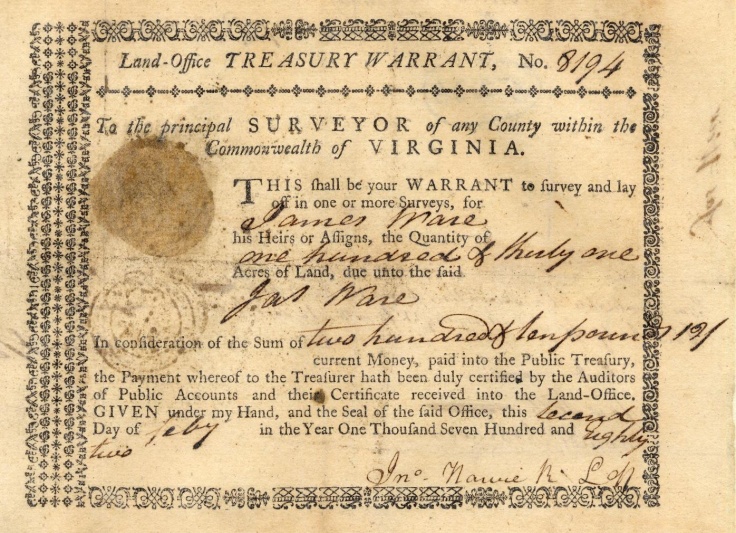 Dated
1782
Dated
1782 -

-
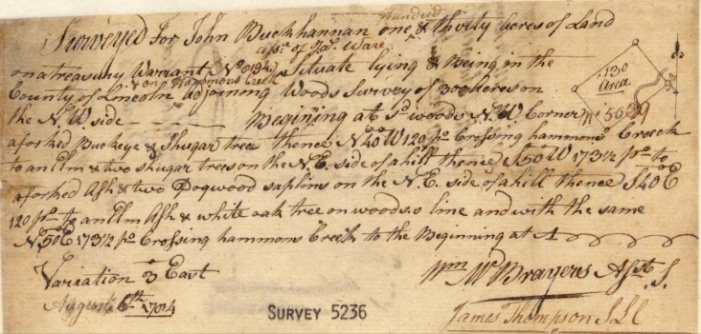 Survey
for James Ware
Sr.
land
Survey
for James Ware
Sr.
land
- 1783
– Taylor, after
selling a lot of land he inherited in Virginia from an uncle, comes
back to Kentucky and another group from Virginia (Orange County)
arrives in the area. (Ref. 2570)
Due to Indian problems, Lewis
Craig
and most of the congregation (i.e., James
Sr.) decide to relocate by crossing
the Kentucky River and moving further north. (Ref.
2570) They organize South Elkhorn Church.
Taylor takes
over the small congregation that is left at Gilbert’s Creek but
later moves to South Elkhorn also. James
Jr. has his survey for 1500 acres in
Kentucky finished, and it is signed by Patrick Henry.
-
- 1784
– Official land warrants are now issued for military service.
Although James Jr. is
a member of an Episcopal church in Frederick Parish, he decides to
visit Kentucky. He stays there all that winter. At this point,
there were only two convenient routes “by
which Kentucky could be approached from Virginia. The water route
by way of the Forks of the Ohio River led downstream to the Falls at
Louisville. The other course began in southern Virginia and
followed the Kentucky Road through Cumberland Gap.”
(Ref. 2570)
Since James
Jr., unlike his father, was coming
from northern Virginia, he probably took the water route. We know
for certain that he traveled by water in 1791. Hickman
arrives in Garrard County and later moves to Woodford County.
 According
to a letter written by Charles Ware, son of James II, “In
the fall of 1784,
James III with his father, James
Ware II,
visited Kentucky and remained there all that winter. This was at
the time when people lived in stations [forts].”
According
to a letter written by Charles Ware, son of James II, “In
the fall of 1784,
James III with his father, James
Ware II,
visited Kentucky and remained there all that winter. This was at
the time when people lived in stations [forts].”
- 1785
– William Hickman
moves up to South Elkhorn Church, and “under
the labours of Craig,
Hickman,
and other visitors, South Elkhorn soon [grows]
up to be a large and respectable church.” (Ref.
Taylor) A committee of Hickman,
Lewis Craig,
James Rucker, and William Cave meet to decide the future of
Gilbert’s Creek. It will ultimately be dissolved the following
year.
1786 -
Lewis
Craig,
who was chosen
pastor of South Elkhorn Church at the time of its constitution, helps
the church continue to prosper. He also
helps organize Bryan’s Station which
will become David’s Fork Baptist Church where grandchildren of
James
and Agnes will attend. James
Ware Jr. officially patents his land
grant.
 Ware,
James. Grantee. Land grant
14 August 1786
Ware,
James. Grantee. Land grant
14 August 1786

Location:
Fayette County, Kentucky
Description:
1500 acres on the dividing ridge between Stoners and
Hingstons
Fork of Licking
- Source:
Land Office Grants No. 4, 1786, p. 375 (Reel 70) Part of the index
to the recorded copies of grants issued by the Virginia Land Office.
The collection is housed in the Archives at the Library of Virginia
1787
– James
Jr. enters into bond with
Daniel Morgan, Marquis Calmes, and Edward
Snickers in Virginia, and there is a huge Baptist revival going on
where James Sr.
now lives in Kentucky.
 Bond,
4 April 1787, Edward McGuire, Edward Snickers, Marquis Calmes, Robert
Wood, James Ware,
Daniel Morgan, and Burnett Williams to Jacquilin Ambler
Treasurer of Virginia. Recorded
in Frederick County 4 April 1787
Bond,
4 April 1787, Edward McGuire, Edward Snickers, Marquis Calmes, Robert
Wood, James Ware,
Daniel Morgan, and Burnett Williams to Jacquilin Ambler
Treasurer of Virginia. Recorded
in Frederick County 4 April 1787
1788
– Forks of Elkhorn Church
is formed as an “arm” of South Elkhorn Church - with William
Hickman
as the first minister. The congregation builds a log cabin but later
upgrades to a frame meetinghouse with a slave gallery. (The
new building was located at the crossroads of Steele’s Ferry and
Lexington-Leestown Roads in order to take advantage of increasing
road travel.) Woodford County
is formed and “when they surveyed the line
that separated the county of Franklin from Woodford, the line passed
directly through the farm of James
Ware Sr.
and within a short distance of
his log residence. It separated his farm into two almost equal
parts, one in Franklin and the other in Woodford, but the residence
went into Franklin County.” (Ref.
874)
His home will (one day) be called
Wareland.

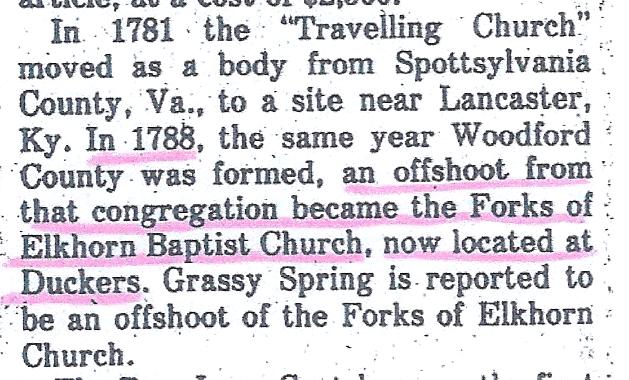
 (Ref. 2291)
(Ref. 2291)
Meanwhile,
James Jr. buys
more land in Frederick County in December.
 Deed, 12 December
1788, for 478 acres in Frederick County from
Hugh Nelson of Yorktown to James
Ware of Frederick County -Recorded 7 July 1789.
Deed, 12 December
1788, for 478 acres in Frederick County from
Hugh Nelson of Yorktown to James
Ware of Frederick County -Recorded 7 July 1789.
- Located
in oversize, Virginia Miscellany box 3, folder 4.
-
- 1789
- James Ware Jr.,
at age 48, re-visits
Kentucky and leaves his two sons (Thompson and James III) while he
returns to Virginia to make plans for the move. James
Sr., in all likelihood, makes contact
with his two grandsons during this time.
 “He [James
Jr.] then, in the year 1789, revisited this country
and brought with him your Uncle Thompson and your father [James
III] and left them here.” (Letter written
by Charles Ware)
“He [James
Jr.] then, in the year 1789, revisited this country
and brought with him your Uncle Thompson and your father [James
III] and left them here.” (Letter written
by Charles Ware)-
- 1790
- James Ware Sr.,
age 76, writes his Last Will and
Testament and has it signed by William
Hickman. His sons, William
and Edmund, both show
up on the tax records with him in Kentucky.
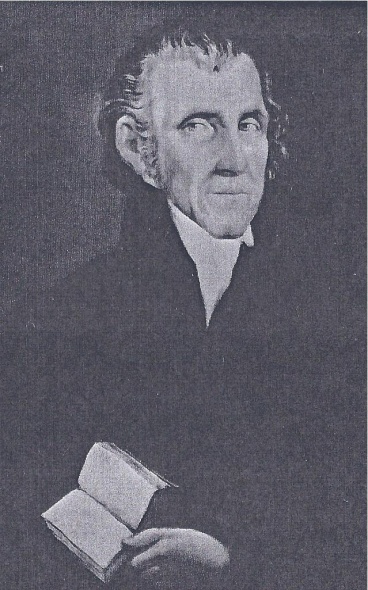

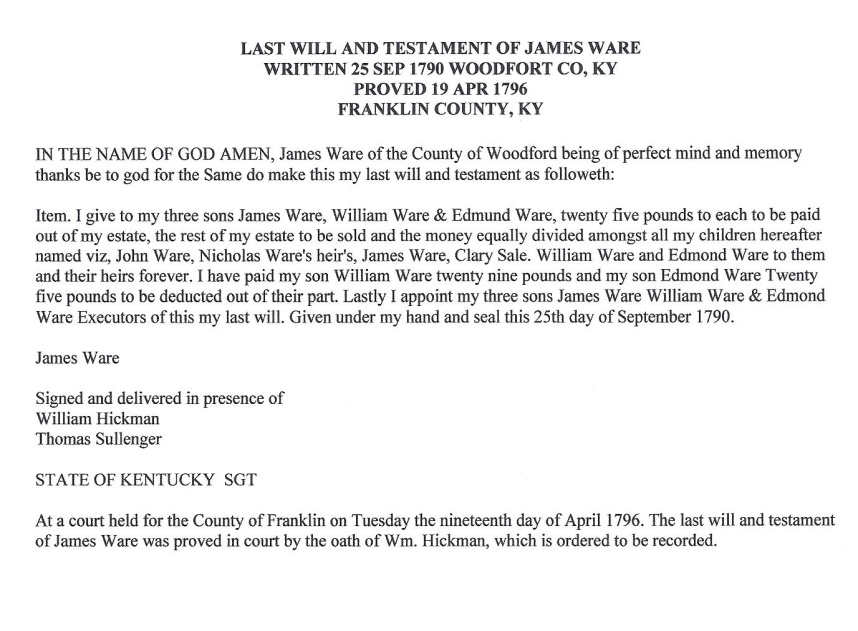

-
William
Hickman (Ref. 2527)
Will for
James Ware Sr.
-
- 1791
– Hickman
goes back to Virginia for a visit. James
and his two sons (William,
and Edmund)
are all still paying taxes in Kentucky. His other son, James
Ware II,
age 50, now relocates to Kentucky as
well. He settles closer to the Lexington area.
Dr.
Ware (James Jr.)
came to Kentucky by a different route than his father, but the
journey was equally difficult. “The old
trail had much to be desired. It was wide enough only for packhorses
and traveling folks. One source says that during the summer and fall
of 1784, hostile Cherokee Indians killed more than 100 travelers on
the Kentucky side of the gap. The result of this carnage was that
travel in large groups was deemed most appropriate.”
(Ref. 2569) Cautious
travelers sought another option altogether.
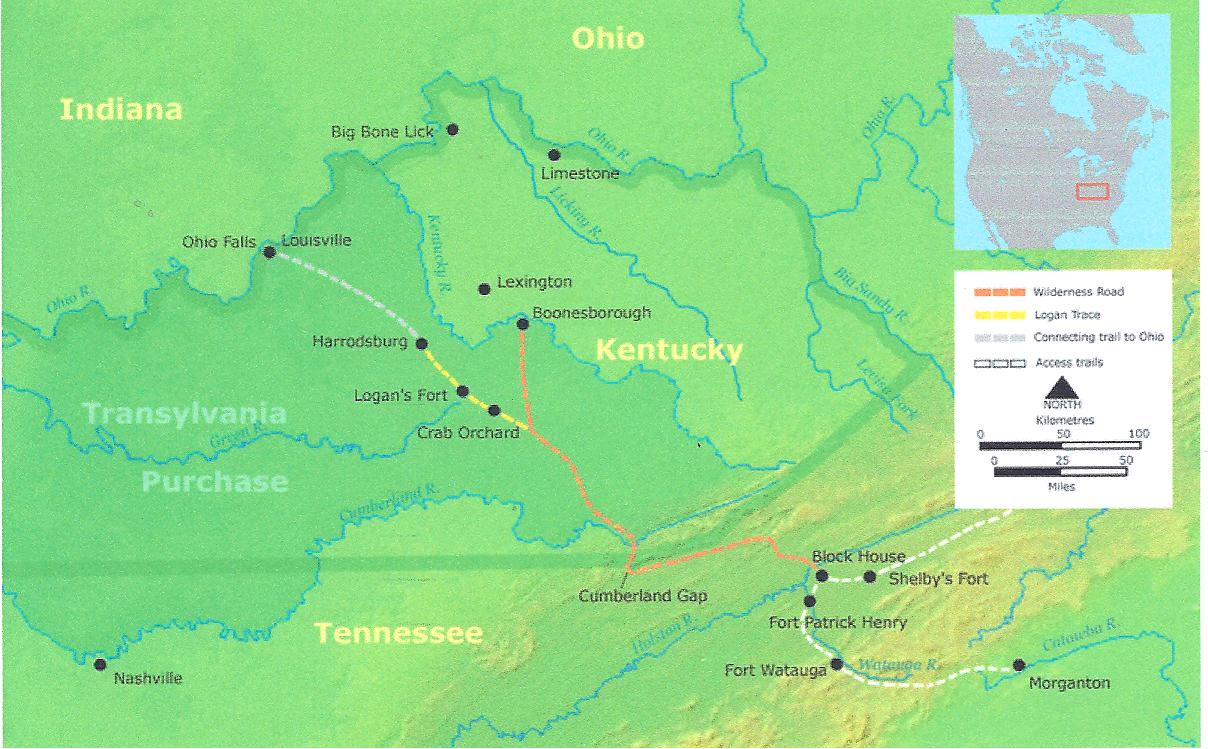
-
Routes to Kentucky
X way James
I came X way
James II came
-
“By
the beginning of the nineteenth century, the population of Kentucky
had swelled to more than 200,000. Many came over the Wilderness
Road, the route first laid out by Daniel Boone for the Transylvania
Company. But a majority of settlers avoided overland passage and
made their way to Kentucky by traveling down the Ohio River.”
(Ref. 2569) It is
difficult to say which was the more toilsome. Lewis
Craig traveled by land, and John
Taylor by water.
- Since
Polly, the daughter of James
Jr., wrote that “we
descended the Ohio
in flat boats in momentary apprehension of being attacked by the
Indians,” we
know that this second Ware migration was done by water.
(Ref. 602)
Family letters also tell
us that James
“sent out some Negroes and an overseer to
make a settlement and clear some ground.” (Ref.
2) It was still a massive undertaking, but the
family arrived “on June 16, 1791.”
(Ref. 35G)
-
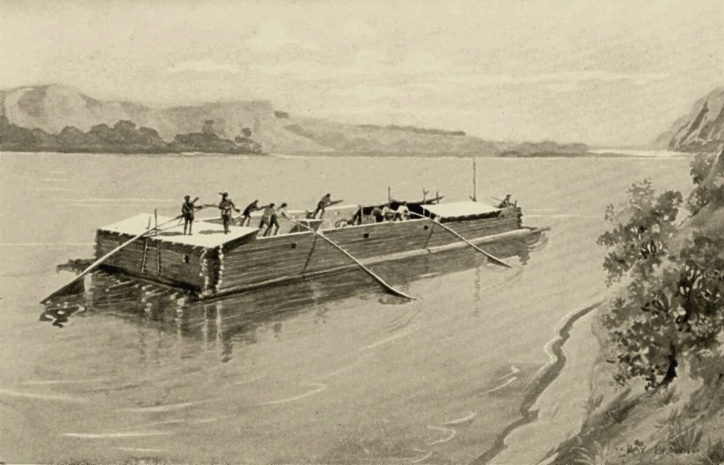
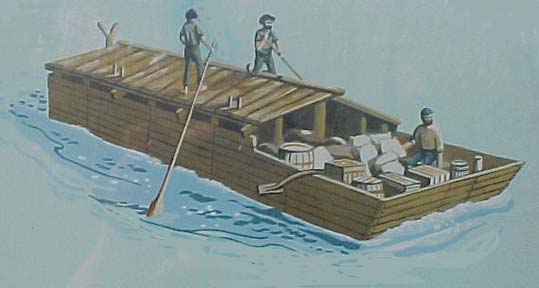
Samples
of what flatboats looked like
-
“Early
flatboat travelers were subject to Indian attack, so the boats were
built like floating forts . . . windows, if any, were small and had
sliding shutters. The walls were pierced with loopholes through
which guns could be fired. Gradually, flatboats became more
comfortable. The cabins were divided into chambers, and many had
brick fireplaces and chimneys for heating and cooking, though a
basic flatboat only had a sandbox fireplace.”
(Wikipedia)
-
1792
– James
Jr. becomes fully vested in his new
locale.
“In
1792, he
built his home on the old Ironworks Pike, just
east of the Bryan Station Pike. The Dr.
James Ware house still stands
at the intersection. . . .” (Ref. 939)
James
was also involved with civic duties and was appointed as a justice
for Fayette County this year.

 Report of
new appointments made in 1792
Report of
new appointments made in 1792
- The
youngest son of James
and Agnes,
Edmund Ware, was very active in the
Forks of Elkhorn congregation. By 1792,
he was elected a deacon. James
Jr. would later join this church in
1801.
-
The
three years from 1792 to 1795 were full and active ones for all the
Ware family. Homes were expanded, livestock imported, babies
birthed, and reputations made. The once “wild” Kentucky was, by
now, the 15th
state in the union.
- 1796
– James Ware Sr. dies
at the age of 82. His property (later to be known as Wareland) is
sold and bought back by his sons William and Edmund. Edmund’s
section will eventually be named by subsequent owners as Locust Hill
and then Scotland.
-
In
studying the events from 1767 to 1796, it is hard to overlook the
connections between James
Sr., Lewis
Craig, and William
Hickman. There has long been
speculation on why James and Agnes would choose to sell all their
property in Spotsylvania and relocate to Kentucky. With the death
of their son Richard and few records for Clary, we are left with
their remaining five children to further guide our investigation.
With them, thankfully, there are documents to verify and
substantiate what we know about them. Nicholas left the Anglican
faith, moved to South Carolina, and became a charter member of the
Turkey Creek Baptist Church. James Jr., in 1801, joined the Baptist
church in Kentucky – as did his brothers, William and Edmund.
“The Records of the Forks of Elkhorn Baptist Church for 1800-1803”
state that in 1801, “a meeting was held at
William Ware’s.” Later, in 1812,
William served on a committee to find a location for a new
meetinghouse. Edmund was not only a member of the Forks of Elkhorn
Church but a deacon. The only Ware son who did not convert to the
Baptist faith was eldest son, John, who decided
to stay in Virginia. This, alone, would
lead one to think that religion played a large role in the move
westward.
-
Although
there is no hard and fast ‘proof’ that the “James Ware”
identified in Caroline County (who preached and was jailed for his
Baptist beliefs) is the same as the Ware patriarch who moved to
Kentucky with the Traveling Church, there seems to be an abnormal
amount of coincidences that would have to be reconciled for that not
to be the case. We know for a fact that James Sr. and Agnes sold
all their property in Spotsylvania – the very place where the
Upper Spotsylvania Baptist Church was formed and became
the Traveling Church. There is a documented land warrant for James
Ware in the very area the church settled, and when they relocated
and the Forks of Elkhorn Church was formed, we know James and
his sons attended there.
-
Possibly
the best proof of all is the Last Will and Testament of James
Sr., which lets us know that (not
only was he already in Kentucky in 1790), he was close enough
friends with William Hickman
to have him witness this important document. Tax records also
verify the fact that James,
William, and Edmund were all paying taxes as early as 1790. The
family letters (dating back to the late 1700s) paint a clear picture
that James Jr.
followed his father’s exodus to Kentucky – only James
Jr. chose to travel by water instead
of tackling the Wilderness Road. Both methods of transportation
were dangerous, and both father and sons (not to mention their
wives, daughters, and other family members) endured much to secure a
new life for themselves in the Bluegrass state. The rewards of
their bravery, however, would be far-reaching.
-



 Photos
from Colonial Williamsburg
Photos
from Colonial Williamsburg
 Photos
from Colonial Williamsburg
Photos
from Colonial Williamsburg
 1721-1730
1761 – 1770
1721-1730
1761 – 1770

![]()
![]()
![]()
![]() “James
Pitman
. . . was
arrested in 1772
along with James
WARE
and
imprisoned
for 16 days in Caroline County's jail for having preached in
their
home."
Caroline
County, VA, Order
Book,
1772-1776
“James
Pitman
. . . was
arrested in 1772
along with James
WARE
and
imprisoned
for 16 days in Caroline County's jail for having preached in
their
home."
Caroline
County, VA, Order
Book,
1772-1776![]() “There
was preaching in the homes in 1771-1773 by such preachers as Lewis
CRAIG
and John WALLER. This was unlawful so at least two citizens, James
WARE and
James PITMAN, were jailed for allowing their homes to be used for
such a gathering.”
Virginia
Baptist Historical Society in Richmond, Virginia
“There
was preaching in the homes in 1771-1773 by such preachers as Lewis
CRAIG
and John WALLER. This was unlawful so at least two citizens, James
WARE and
James PITMAN, were jailed for allowing their homes to be used for
such a gathering.”
Virginia
Baptist Historical Society in Richmond, Virginia Records
for Overseer
Records
for Overseer Excerpt
from book
Excerpt
from book![]()
![]()
![]()
![]() Ware
Family History
American Genealogical Research Institute, Washington DC, Heritage
Press, 1978
Ware
Family History
American Genealogical Research Institute, Washington DC, Heritage
Press, 1978![]()
 (Ref. 894)
(Ref. 894)![]() “James
Ware Sr.
did patriotic service in Virginia.”
American
Genealogical Research Institute in Washington, D.C.
“James
Ware Sr.
did patriotic service in Virginia.”
American
Genealogical Research Institute in Washington, D.C.![]() James
Ware “rendered service in the revolution, as did several of his
sons, and . . . he moved to Kentucky after
hostilities had subsided.”
The Register of the
Kentucky State Historical Society,
Vol. 19 KY
James
Ware “rendered service in the revolution, as did several of his
sons, and . . . he moved to Kentucky after
hostilities had subsided.”
The Register of the
Kentucky State Historical Society,
Vol. 19 KY![]() Military
records show James Jr.
was “a
cavalry soldier in a Virginia unit.” He
is listed as a Revolutionary War Patriot.
Military
records show James Jr.
was “a
cavalry soldier in a Virginia unit.” He
is listed as a Revolutionary War Patriot.![]() DAR Patriot
Index, 2003, NSDAR
DAR Patriot
Index, 2003, NSDAR![]()

 Revolutionary
War Pension
Revolutionary
War Pension
 Forks of
Elkhorn Church,
by Emina Jett Darnell, 1939
Forks of
Elkhorn Church,
by Emina Jett Darnell, 1939 Land
warrant for James
Ware Jr.
Land
warrant for James
Ware Jr.![]() Interaction
between James Ware and Simon Kenton
Interaction
between James Ware and Simon Kenton
![]()
![]() Interaction
between Thompson Ware and Simon Kenton
Interaction
between Thompson Ware and Simon Kenton
![]()
 2532
2532 Cumberland
Gap
Cumberland
Gap
 Dated
1782
Dated
1782 Survey
for James Ware
Sr.
land
Survey
for James Ware
Sr.
land
![]() According
to a letter written by Charles Ware, son of James II, “In
the fall of 1784,
James III with his father, James
Ware II,
visited Kentucky and remained there all that winter. This was at
the time when people lived in stations [forts].”
According
to a letter written by Charles Ware, son of James II, “In
the fall of 1784,
James III with his father, James
Ware II,
visited Kentucky and remained there all that winter. This was at
the time when people lived in stations [forts].”
![]() Ware,
James. Grantee. Land grant
14 August 1786
Ware,
James. Grantee. Land grant
14 August 1786
![]()
![]() Bond,
4 April 1787, Edward McGuire, Edward Snickers, Marquis Calmes, Robert
Wood, James Ware,
Daniel Morgan, and Burnett Williams to Jacquilin Ambler
Treasurer of Virginia. Recorded
in Frederick County 4 April 1787
Bond,
4 April 1787, Edward McGuire, Edward Snickers, Marquis Calmes, Robert
Wood, James Ware,
Daniel Morgan, and Burnett Williams to Jacquilin Ambler
Treasurer of Virginia. Recorded
in Frederick County 4 April 1787
![]()

![]() (Ref. 2291)
(Ref. 2291)





![]()
 Report of
new appointments made in 1792
Report of
new appointments made in 1792![]()
